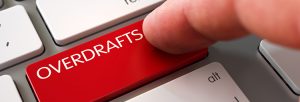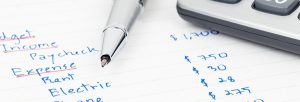A guide to paying off your overdraft debt
Table of contents
Many of us dip into our overdraft before payday and sometimes – if the month has been a particularly busy one or if any unexpected payments have surfaced – this means what we do receive from our wages could quickly be eaten up to cover what we now owe.
It can soon become a vicious circle and if you’re deep in the red, sometimes you may not even get out of your overdraft when payday arrives.
This is why it’s a good idea to look into how to get out of overdraft debt, to avoid all those extra charges and rising interest rates that your bank may charge – making what was once a manageable amount to repay, tough to handle.
Here is how you can get out of your overdraft – and stay out:
What is an overdraft?
An overdraft is there to act as a credit buffer for your current account. It’s important to remember that each time you go into it you are borrowing money, like taking on a small loan.
There are two types of overdraft available:
Arranged overdraft
This means the amount in your overdraft is an agreed amount with your bank. For example, you may have a £1,000 overdraft which means you can borrow up to this amount without incurring any extra charges – on top of the agreed interest you signed up for.
Unarranged overdraft
This is when you spend more money than what is in your account and do not have an agreed borrowing amount with the bank. The daily charges, should this happen, can be very high – although most banks cap these at a certain amount – so it’s recommended you avoid using an unarranged overdraft.
Interest and fees on overdrafts
The interest and fees applied to overdrafts vary per bank but essentially if you go over your agreed borrowing amount you may be charged some form of fee. This can make an overdraft unmanageable quickly – many banks charge from £1 per day, which may not sound like a large amount but if left over a long period of time can add up to a substantial cost to pay back.
When it comes to interest rates, these are agreed on an overdraft but only start to apply if you actually borrow the money.
Free fee buffers
Some banks allow a buffer amount of money for emergency situations. The amount varies greatly between banks and types of account but it’s worth checking if yours offers this or if it can be added to your account.
For now, here are some tips on how to get out of your overdraft or avoid it altogether:

Create a strict budget to free up cash
Budgeting is a really good way of ensuring you always have a little cash spare at the end of the month. Even if it’s just a tenner, it means you haven’t slipped into your overdraft and started being charged for the privilege – if your account does charge interest or you go over the agreed amount. If you’re paying off your overdraft, any spare money can be used to pay the debt.
If you’ve never created a budget before, here are some tips to work by:
Decide what is a necessity
Make sure what you have in your bank account at the start of the month goes towards covering the cost of essential expenses first, such as your mortgage or rent payments, utility bills, petrol or public transport costs and food shopping. The rest of your money can then be spent on other things, such as entertainment and clothing.
Some people work to the 50/20/30 rule, which means 50% of your income is used for essential living expenses, 20% goes towards repaying debts or to build up your savings and 30% is disposable income for yourself.
You can change these percentages if you like, but for many people, it’s a good way of splitting up what they have in the bank and keeping control of their finances. You can find out more about how to avoid debt and this budgeting rule here.
Find a way to keep note of what you’re spending
Find a way to keep note of everything you spend – even while on the move – to monitor whether you’re sticking to your budget or not. You could use a budgeting app, a small notebook or just the notes section on your phone.
This may seem tedious at first but it will become a habit. Keeping a close eye on your bank account also means you can spot other issues early, such as fraudulent activity or if you have been overcharged for something.
Find the best deals
Setting up a budget means sitting down and carefully checking what is going in and out of your bank account. This includes checking all your bill payments and amounts. If you don’t pay attention when contracts such as your car insurance renews – if you have automatic renewal set up – you may be paying a lot more than you need to.
It’s a good idea to be aware of the date when contracts and agreements you have set up end, then you can use the month before to shop around for a better deal and enjoy a lower price. What you save can then be put towards repaying your overdraft debt.
Look into finding alternatives for expenses, such as your energy supplier or mobile phone provider. Many people use a comparison site but it’s also a good idea to speak directly to a person and discuss your account with them – they may be able to find a way to discount your monthly costs to keep you as a customer. Bear in mind that if you want to cancel a contract earlier you may have to pay a fee, so check if this outweighs the money saved or not before making the move.
Remove unnecessary expenses
Go through your bank statements and look for any expenses which are on there you don’t feel necessary – such as a subscription to a streaming site you rarely use or a gym membership you perhaps signed up for in the New Year but haven’t been to since March (don’t worry, we’re all guilty of that).
Cancel these if you can and use the spare cash to ensure you don’t go into your overdraft at all or to put it towards paying off your overdraft debt. It could also be used to pay off any other bills you may be struggling with. Again, there may be a fee to do this so bear this in mind – check your agreement before you do anything to ensure you are not chased for this fee later.
Move to an account with a better interest rate
Even if you are in your overdraft, it is possible to move current accounts, which you can do to enjoy the benefit of an interest-free or lower interest option account. Before you do anything though, check if you are paying interest or not on your current agreement.
You can do this by viewing any paperwork that came when you set up your overdraft or give your bank a call and an advisor should be able to help you confirm this information.
Be sure to check how long the interest-free period lasts on a new overdraft – most accounts offer a 12 month 0% interest period. You can then use the budgeting solution explained above to build up enough spare cash to pay off your overdraft debt during this time.
Switching to a new account should be free to do and most banks offer this service as standard. You shouldn’t have to worry about doing anything in terms of switching payments from one account to another.
When it comes to obtaining an overdraft with the new bank, they may want proof of how much your current overdraft is – so you will probably be asked to provide a bank statement to show this.
Consider moving the debt to a 0% interest credit card
If you are struggling to pay off your overdraft, including interest and charges, moving this debt to a no interest credit card could be an option.
It could mean you pay off what you owe on your overdraft, then work to clear the credit card during the interest-free period. Make sure you don’t spend on this credit card though, as you will only have more to pay back.
There are a huge number of interest-free credit cards available, so use a comparison site to find one that works for you.
Reduce your overdraft limit
If you feel an overdraft is necessary – after all, they can help when you are suddenly faced with a large expense, such as car repair – speak to your bank about reducing the overdraft limit. They may work with you to set up an arrangement that reduces the amount you have in your overdraft automatically each month. This could ultimately lead to closing the account altogether.
You could also do this as you pay off some of the debt. So, for example, if you have an overdraft limit of £1,000 and remove £100 worth of debt, ask your bank to reduce the limit to 0 and so on.
Close your overdraft once the debt is paid
If you don’t trust yourself to not dip back into your overdraft, get rid of it altogether. You can close your overdraft by visiting your local bank’s branch and asking someone to remove it from your account. This could teach you to manage your budget better and make sure you know where every penny is being spent.
